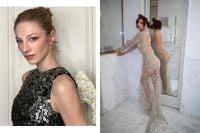The Metropolitan Museum of Art is making history with its latest exhibition, "Superfine: Tailoring Black Style," which opened on May 10, 2025. This groundbreaking showcase is the first of its kind to focus exclusively on Black designers and the art of menswear, a significant milestone in the fashion world. The exhibition not only highlights the creativity and talent of contemporary designers but also pays homage to the rich history of Black dandyism, a cultural phenomenon that has shaped fashion and identity for centuries.
Among the featured designers is Jacques Agbobly, a Brooklyn-based fashion designer whose work is prominently displayed in the exhibit. Agbobly, who has only been in the fashion industry for five years, was ecstatic when he received the invitation from the Met to showcase two of his designs. "I was just floored with excitement," Agbobly said. "I had to check to make sure it was from an official email. And then the excitement came, and I was like … am I allowed to say anything to anyone about it?"
The exhibit, curated by Monica L. Miller, draws inspiration from her book, "Slaves to Fashion: Black Dandyism and the Styling of Black Diasporic Identity." Miller describes the range of designs as phenomenal, emphasizing the importance of showcasing emerging Black designers alongside established names. "It’s super exciting to showcase the designs of these younger and emerging designers," she said. "And to see the way they’ve been thinking about Black representation across time and across geography."
This year’s Met Gala, which took place on May 5, 2025, raised a record $31 million, surpassing last year’s total of $26 million. The gala’s theme, "Tailored for You," is directly linked to the exhibition, inviting guests to explore the legacy of Black style and dandyism on the red carpet. This is the first Met Gala in over two decades to focus exclusively on menswear, highlighting the cultural significance of tailoring within the Black community.
The exhibit is organized into twelve conceptual sections, including Ownership, Presence, Distinction, Disguise, Freedom, Champion, Respectability, Jook, Heritage, Beauty, Cool, and Cosmopolitanism. Each section tells a unique story about the evolution of Black style, beginning with the "ownership" section, which features two livery coats worn by enslaved people—one from Maryland made of purple velvet and another of tan broadcloth worn by an enslaved child in Louisiana just before the Civil War. These garments symbolize the wealth of their owners, with the enslaved themselves becoming items of conspicuous consumption.
In contrast, contemporary pieces include a striking ensemble by British designer Grace Wales Bonner, made from crushed silk velvet and embroidered with crystals and cowrie shells, historically used as currency in Africa. Another notable piece is the "dollar bill suit" by the label 3.Paradis, which features a laminated one-dollar bill stitched to the breast pocket, symbolizing the absence of wealth.
The "disguise" section features 19th-century newspaper ads that announced rewards for capturing runaway enslaved people, often noting their fondness for dressing well. Miller explains that dressing above one’s station was sometimes a matter of life and death. The contemporary portion of this section includes embroidered jackets by Off-White that challenge traditional gender roles.
Portraits from the early 19th century depict successful Black men dressed in the finest fashions of the day, representing the beginnings of a Black middle and upper-middle class in America. Figures like W.E.B. Du Bois and Frederick Douglass are highlighted in the exhibit for their impeccable style, which served as a form of resistance against racism. Du Bois, often regarded as one of the best-dressed men in turn-of-the-century America, is represented through receipts for tailors in London and suit orders from Brooks Brothers.
Agbobly’s designs are particularly poignant, reflecting his heritage and personal experiences. One of his bright-colored ensembles is inspired by the hues of bags used by West African migrants, while his denim suit, embellished with crystals and beads, pays tribute to the hair-braiding salons he frequented as a child and the jewelry worn by his family during church services. Agbobly expressed his joy at being part of such a significant exhibition, stating, "Everyone knows about it. I keep screaming. If I can scream on top of a hill, I will."
The exhibition also delves into the evolution of Black dandyism, a term that has come to symbolize the intersection of style, resistance, and cultural pride. Figures like Douglass and Toussaint Louverture used their fashion choices as tools of self-expression and defiance against oppression. As Miller notes, "Dandyism is about taking space. As a Black designer, as a queer person, a lot of it is rooted in people telling us who we should be or how we should act … dandyism really goes against that. It’s about showing up and looking your best self and taking up space and announcing that you’re here."
As the exhibit prepares to open to the public, it promises to be a powerful exploration of Black style, celebrating the artistry, history, and cultural significance of tailoring within the Black community. The legacy of Black dandyism continues to influence contemporary fashion, challenging norms and redefining masculinity in profound ways.
With the Met Gala and the accompanying exhibition, the Metropolitan Museum of Art is not only celebrating fashion but also recognizing the vital contributions of Black designers and the rich tapestry of Black history in shaping the world of style.





